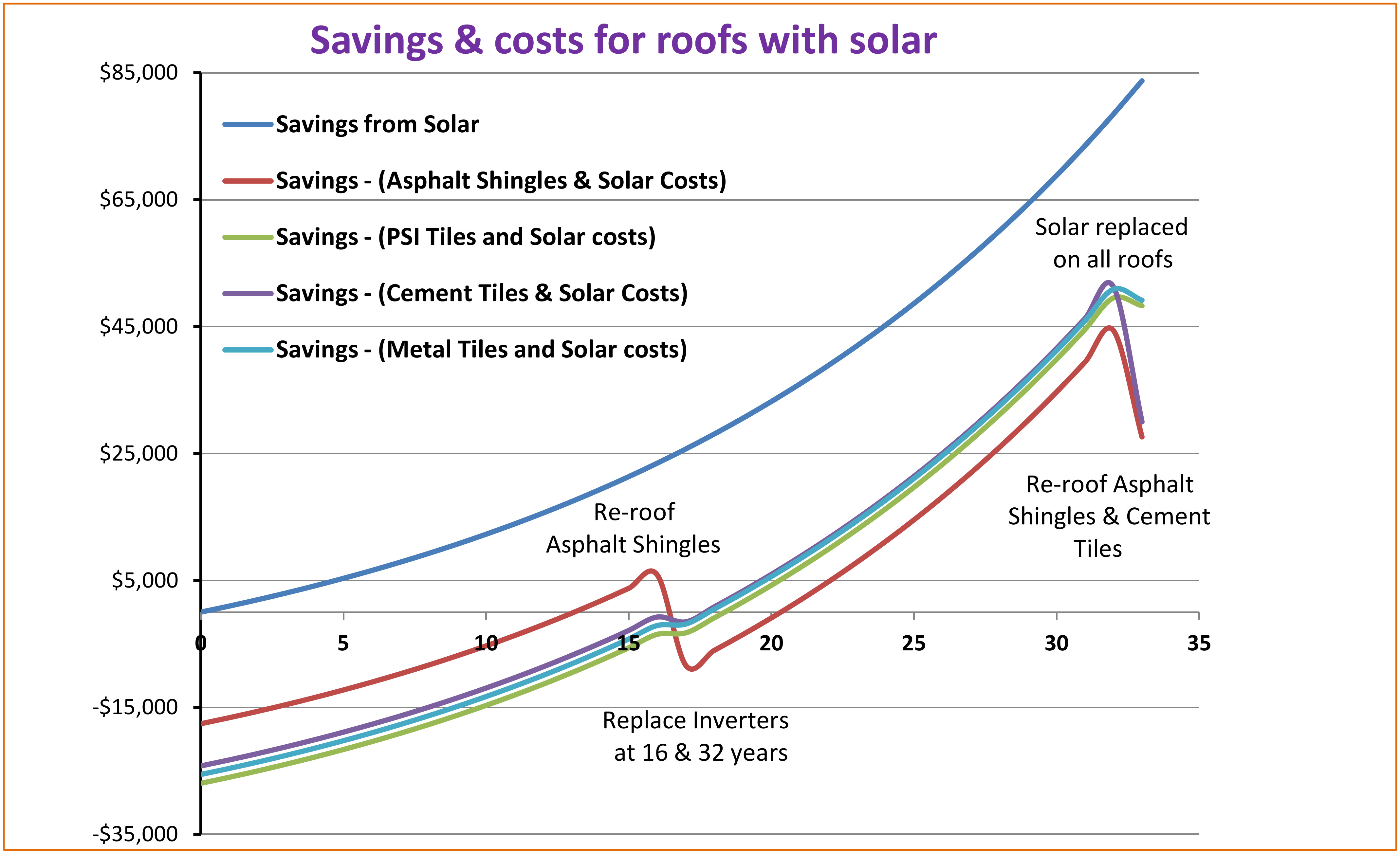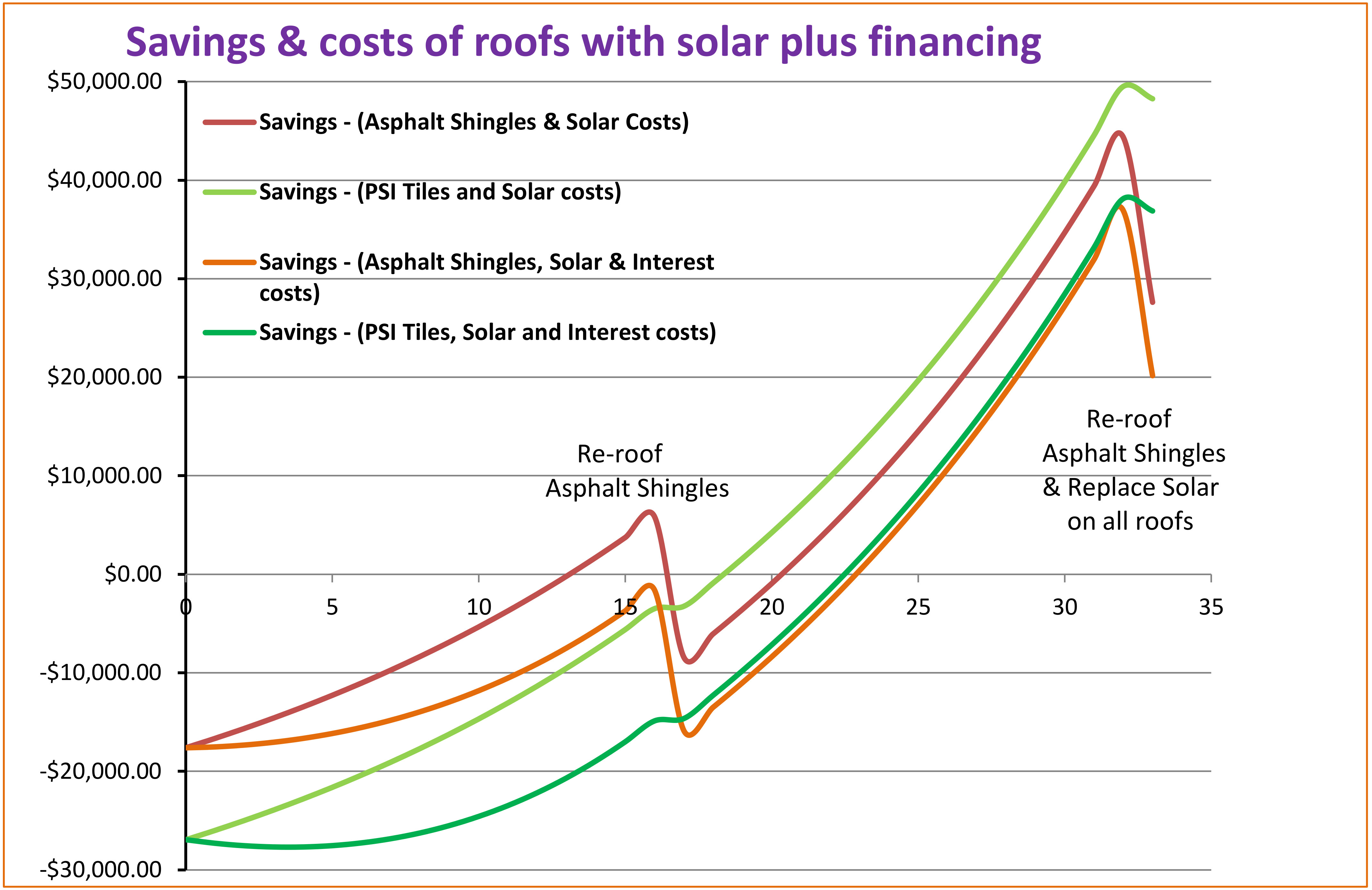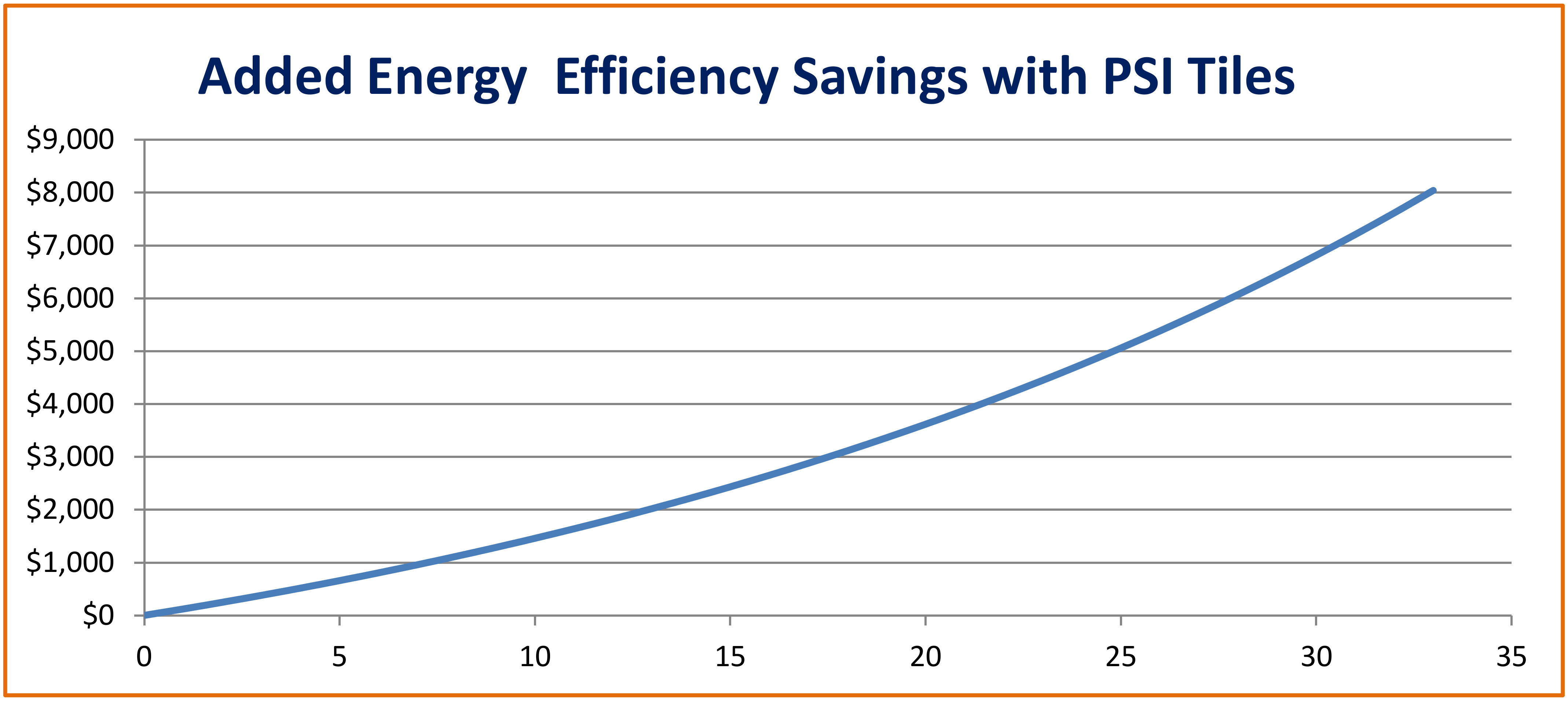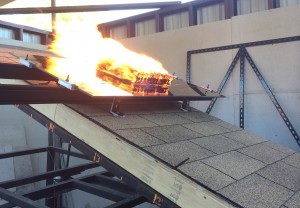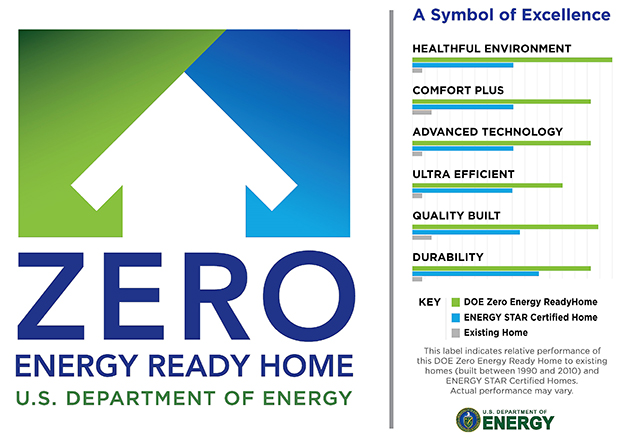Category Archives: Solar Roof Tiles
A new roof that pays for itself?
For most people, the home is a significant investment in terms of money, time and effort. When a new roof is needed, evaluating the available choices of roofs, along with the possible solar options, are important for getting the most out of the money to be spent.
Looking at the various roof types life expectancy, impact on energy bills, and the effect on resale value over time, all help in making an informed decision. Adding solar to the roof affects how the home looks and can provide financial returns over time that can pay for the roof and solar.
Graph A
Metal roofs, lasting 50 years and more, have a lower life cycle cost than asphalt shingle roofs, which last around 16-18 years. Potential buyers can see where the roof is at in its life expectancy and will adjust their offers accordingly. The graph above shows solar savings and solar savings offset by the cost of solar and the various roofs. Solar and the cement tiles are replaced at 32 years and asphalt shingle roofs are replaced at 16 and 32 years. In the graph below, Power Shield, Inc. (PSI) metal roof tiles with integrated solar (BIPV) are compared with asphalt shingle roofs with solar, both types compared with a cash purchase versus financed.
A 1,750 Square Feet (163 SqMtr) house with 2,100 Square Feet (195 SqMtr) of roof area and 3,000 watts max of installed solar was used for the calculations used in the graphs. The average electric rate is $.21/KWhr initially, with annual increases of 6% used in the analysis. The solar panels have 77% of max power available over an average 5.5 hrs of sunlight per day. The solar panels are calculated to lose 2.5% output the first year and 0.5% thereafter. The 30% US investment Tax Credit was applied to the initial costs in the calculations. The finance rate is 5% annually for 15 years for the graph below, with only the initial installation financed (re-roofing, maintenance, new inverters and new solar all considered on a cash basis).
Graph B
The roof type has a major impact on the amount of unwanted hot or cold energy being absorbed into the home or building. Asphalt shingle roofs directly conduct heat into and out of the roof deck and attic, which increases the air conditioning and heating loads versus a roof with above deck ventilation. Some roof types, such as metal, ceramic and cement tiles can be installed so hot air is ventilated away from the building through a chimney effect of heated air between the roof deck and tiles. A ventilated space between the roof and roof deck also acts as an insulating layer during the heating season. Cool roof coatings reflect the heat absorbed from sunlight back into the atmosphere, limiting the amount of heat transferred into the building.
The Power Shield roof system features a cool roof coating, above deck ventilation and is made from recycled and non-combustible, lightweight steel. The graph below shows the additional savings available from air conditioning and heating costs with a Power Shield roof compared to a conventional asphalt shingle roof. The graph shows the same house characterized above and built in the Sacramento, California area before 1980 (1).
Graph C
Another aspect of solar installations is the direction the front (and possibly sides) of the house face and whether the best location is the front of the house. A big influence on solar is the placement on the roof and the sight lines from the street. Power Shield tiles with solar can be placed anywhere on the roof and will look exceptionally well.
Power Shield, Inc. roof replacement of 38 year old cement tiles with about 4200 watts of solar:
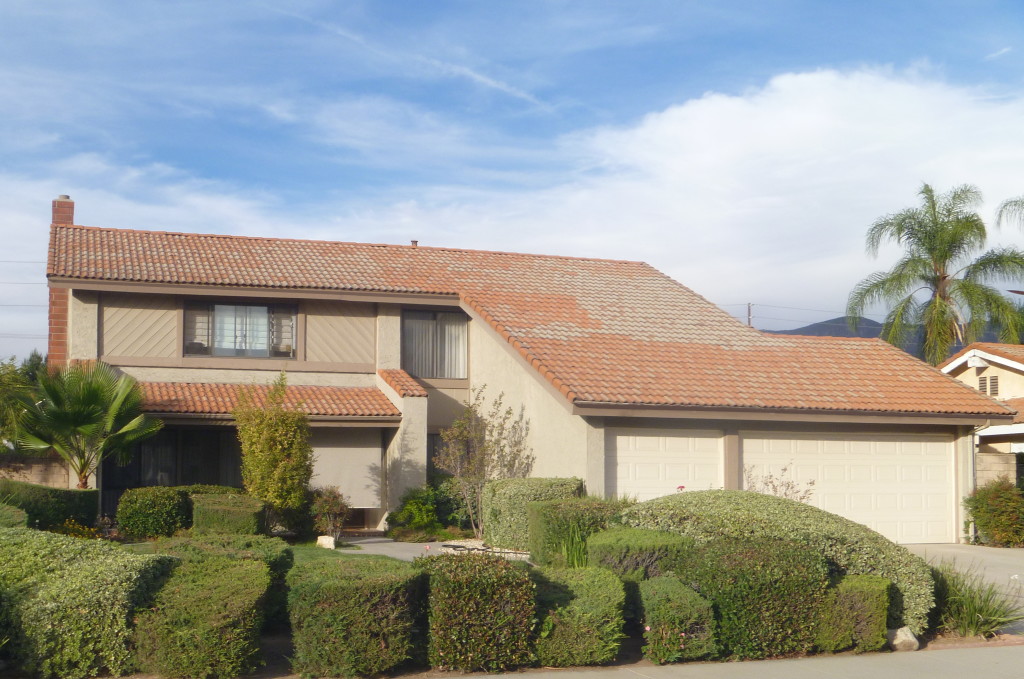
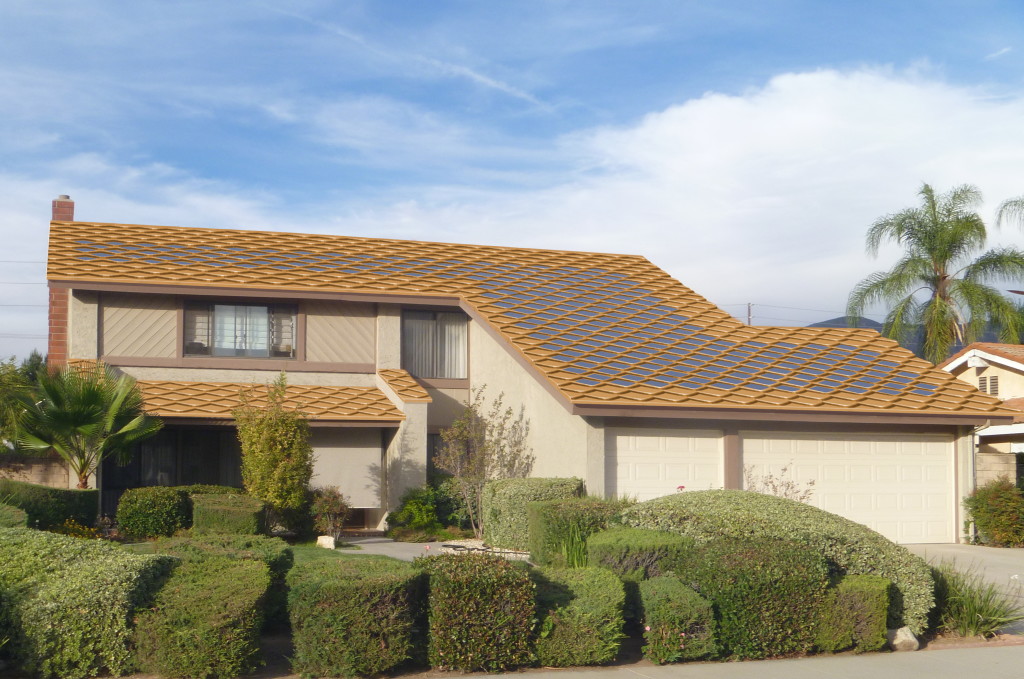
A roof is a major ongoing expense that, like a mortgage, must be dealt with. Buying a new roof is a decision with 15 to 60 year implications. A new solar system has a 25-35 year life expectancy. The decision to go solar provides increased savings every year as the electric utility rates rise. House values fluctuate depending on the life expectancy of the roof and solar. Making a bigger decision up front will add to the returns over time.
Kurt Kramer, Power Shield, Inc.
1. http://web.ornl.gov/sci/buildings/2012/2010%20B11%20papers/64_Miller.pdf
Gallery
Class A Fire Rated solar & roofs in Wildland Urban Interface Areas
On January 1, 2015, jurisdictions throughout the State of California and elsewhere, with designated Wildland Urban Interface Areas (WUI), will begin enforcing the new Class A & B fire ratings for PV systems and roofing. Most PV system products have the lower C rating and this enforcement date may prove a disruption for the PV industry.
If the Authority Having Jurisdiction (AHJ) requires either Class A or B fire ratings for buildings in the Very High Fire Severity Zones and WUI Areas, the requirement will now be enforced for roofing, mounting hardware and solar panels. In 2000, the U.S. Wildland Urban Interface contained more than 12.5 million housing units, a 52 percent expansion from 1970 (see http://www.ucsusa.org article “Playing with Fire” 2014).
The 2011 International Building Code (adapted in many jurisdictions) requires that PV systems have a fire rating that is the same or better than the required fire rating of the roof, which in the WUI areas is generally Class A or B. To properly address this new fire rating requirement, the safety standard UL1703, which regulates the safety of PV modules and panels, was updated in October of 2013 with new fire performance test requirements. As of the fall of 2014, only a few manufactures have evaluated their products to the new version of UL1703. This link provides more info on the new test requirements: http://solarabcs.org/about/publications/meeting_presentations_minutes/2014/pdfs/Guide-FireRatingPVSystems-V2.pdf. The updated UL1703 test requirements do not affect Building Integrated PhotoVoltaics (BIPV) which are fire rated as a roofing product.
Effectively, for many areas where new homes are built or homes re-roofed, the fire classification requirements will be more stringent and the rating will apply to solar panels and mounting hardware. As Power Shield, Inc. goes through testing as a roof and a BIPV product, it intends to achieve a Class A rating for the metal roof and metal solar roof tiles.
Metal Solar Roof Tile Life Cycle Costs

Both a new roof and a solar system are large investments. Can you recoup your investments in both?Recouping a solar investment is appreciated in revenue/savings from annual production and in the resale value of the system at any point in it’s service life.
When installed properly, metal roofing can last as long as fifty years or more, requiring very little maintenance and looking beautiful all the while. Few homeowners realize until after the fact but metal roofing can actually cost as little or less than asphalt roofing. Since asphalt roofing needs to be replaced 2 – 4 times as often as metal roofing. Add a solar system on an asphalt shingle roof and the costs to re-roof will increase. The wear and tear on a roof from solar installation and maintenance can shorten it’s service life. When re-roofing on a solar system, an installation may have to be brought up to current code. Metal tiles are non-combustible and lightweight, allowing them to replace an asphalt roof.
Energy savings from a metal roof with a “cool roof” can be substantial, see a study on roof thermal performance – http://web.ornl.gov/sci/buildings/2012/2010%20B11%20papers/64_Miller.pdf . Power Shield tiles have a double lath installation system that increases the above sheath ventilation – saving money in the summer as well as winter, and maximizing solar tile performance.
Net Zero Energy
Two strengths of the Power Shield roof system – energy production and energy efficiency, are components in the design of Net Zero Energy Buildings.
Energy is produced through the 16 watts of power per solar tile. Building Envelope thermal performance (1) is improved through:
Cool Roof coatings on tile keep it cool and improve energy production. The cool roof coating has high emissivity on the sun side to allow heat to be radiated out, and low emissivity underneath, making the tiles a radiant barrier;
The efficient Above Sheath Ventilation on the tile system provides a chimney effect as warm air flows between the tiles and the roof deck and out from the building. In winter, the air gap between the tiles and roof deck are insulating, reducing the heat transfer out of the attic.
LEED points are also available from the recycled material in the metal roof and the reduction of the heat island effect.
1. http://web.ornl.gov/sci/buildings/2012/2010%20B11%20papers/64_Miller.pdf
Solar Power International Conference
Solar Roof Tiles
Power Shield, Inc. is a company introducing roof tiles that have solar cells embedded into them. The tiles are designed to cover the whole roof and with the large flat surface can support solar cells under glass. Oh, by the way, they look great!
We will be showing the design prior to the product launch and will have the necessary UL, TUV etc. listings.
We are interested in some test roofs, such as a gazebo to showcase prior to product launch.

